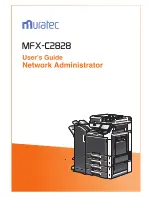
Selecting print media
82
Understanding paper and specialty media guidelines
Selecting print media
Selecting the appropriate print media for the MFP helps you avoid printing problems. The following sections contain
guidelines for choosing the correct print media for the MFP.
•
Paper
•
Transparencies
•
Envelopes
•
Labels
•
Card stock
Paper
To ensure the best print quality and feed reliability, use 90 g/m
2
(24 lb) xerographic, grain long paper. Business papers
designed for general business use may also provide acceptable print quality.
Always print several samples before buying large quantities of any type of media. When choosing any media, consider the
weight, fiber content, and color.
The laser printing process heats paper to high temperatures of 230°C (446°F) for non-MICR applications. Use only paper
able to withstand these temperatures without discoloring, bleeding, or releasing hazardous emissions. Check with the
manufacturer or vendor to determine whether the paper chosen is acceptable for laser printers.
When loading paper, note the recommended print side on the paper package, and load paper accordingly. For detailed tray
loading instructions, see the following:
•
Loading standard or optional 500-sheet trays
•
Loading the multipurpose feeder
•
Loading the 2000-sheet dual input trays
•
Loading the 2000-sheet high capacity feeder
Paper characteristics
The following paper characteristics affect print quality and reliability. It is recommended that these guidelines are followed
when evaluating new paper stock.
Weight
The MFP can automatically feed paper weights from 60 to 176 g/m
2
(16 to 47 lb bond) grain long in the integrated and
optional trays and paper weights from 60 to 135 g/m
2
(16 to 36 lb bond) grain long in the multipurpose feeder. Paper lighter
than 60 g/m
2
(16 lb) might not be stiff enough to feed properly, causing jams. For best performance, use 90 g/m
2
(24 lb
bond) grain long paper. To use paper narrower than 182 x 257 mm (7.2 x 10.1 in.), it is recommended that the weight be
greater than or equal to 90 g/m
2
(24 lb bond).
Curl
Curl is the tendency of media to curve at its edges. Excessive curl can cause paper feeding problems. Curl can occur after
the paper passes through the MFP, where it is exposed to high temperatures. Storing paper unwrapped in hot, humid, cold
and dry conditions, even in the trays, can contribute to paper curling prior to printing and can cause feeding problems.
Smoothness
The degree of smoothness of paper directly affects print quality. If the paper is too rough, the toner does not fuse to the
paper properly, resulting in poor print quality. If the paper is too smooth, it can cause paper feeding or print quality issues.
Smoothness needs to be between 100 and 300 Sheffield points; however, smoothness between 150 and 250 Sheffield
points produces the best print quality.
Содержание InfoPrint 1540
Страница 1: ...Infoprint 1540 1560 1580 MT 4543 User s Guide S510 4381 01...
Страница 2: ......
Страница 3: ...Infoprint 1540 1560 1580 MT 4543 User s Guide S510 4381 01...
Страница 108: ...Clearing jams 106 Clearing jams 4 Remove the jammed paper 5 Close the jam access cover and top door...
Страница 112: ...Clearing jams 110 Clearing jams 230 Jam 1 Open Door D by the duplex rear door 2 Remove the jammed media 3 Close Door D...
Страница 114: ...Clearing jams 112 Clearing jams 6 Pull the print media up 7 Close Door E 8 Close Door A 9 Touch Continue...
Страница 115: ...Clearing jams 113 Clearing jams 231 Jam 1 Open Door D by the duplex rear door 2 Remove the jammed media 3 Close Door D...
Страница 118: ...Clearing jams 116 Clearing jams 2 Open Door B 3 Remove the jammed media 4 Close Door B...
Страница 119: ...Clearing jams 117 Clearing jams 5 Slide the feeder firmly against the MFP 6 Touch Continue...
Страница 162: ...161 Index software application overrides 11 U USB Direct interface 54 USB flash memory device 54 V verify print 59...
Страница 165: ......
Страница 166: ...Printed in USA S510 4381 01...
















































